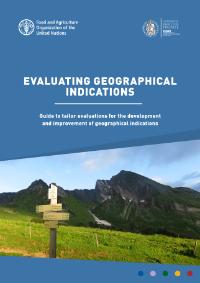VIDEOS
GEOGRAPHICAL INDICATIONS -
AN OPPORTUNITY FOR BIODIVERSITY
GEOGRAPHICAL INDICATIONS -
CONNECTING PEOPLE, PLACES AND PRODUCTS
PUBLICATIONS
Worldwide Perspectives on Geographical Indications: Crossed Views between Researchers, Policy Makers and Practitioners
Based on a 2022 international event organized by the Food and Agriculture Organization (FAO), the Centre de coopération internationale en recherche agronomique pour le développement (CIRAD), in collaboration with the Swiss Intellectual Property Institute (IPI) and oriGIn (Organization for an International GI Network), this book explores global perspectives on Geographical Indications (GIs), featuring contributions from researchers, policymakers, and practitioners. It covers GI legal frameworks, management, market dynamics, sustainability, and consumer welfare, highlighting their role in linking product quality and reputation to geographic origin.
Developing a roadmap towards increased sustainability in geographical indication systems
This guide and the associated toolkit provide GI organizations with practical step-by-step guidance to develop and implement their own sustainability roadmaps, based on participatory processes.
Through these processes, GI organizations can strengthen their governance and legitimacy, and become agents of change for increased sustainability.
Promoting Sustainability through the Registration of Geographical Indications
This publication provides guidance for public authorities in examining requests for the registration of geographical indications.
The publication highlights the importance of public institutions to support the creation of enabling environments that contribute to the development of sustainable agrifood systems through geographical indication approaches.
Proceedings - Third regional consultation on GIs in Europe and Asia
In 2021, FAO and the Organization for an International Geographical Indications Network (oriGIn) hosted the ‘’ Third regional consultation on geographical indications in Europe and Central Asia”.
The consultation focused on GIs’ global trends, the state of affairs in various countries and recommendations for future activities.
These proceedings provide an overview of the topics discussed, key recommendations and country case studies.
Labelling and certification schemes for Indigenous People's foods
This review analyses the potential of labelling and certification schemes for Indigenous Peoples to be able to market their food products. Specifically, it focuses on schemes that are designed by, with and for Indigenous Peoples, and that can provide economic, social and environmental benefits while protecting and promoting their unique values centered around the respect of life and Mother Earth.
Eleven examples in this review cover innovative schemes implemented by Indigenous Peoples and practitioners in Africa, Asia, Central and South America and Oceania. They include territorial labels, geographical indications (GI), and participatory guarantee schemes (PGS), among others.
Evaluating geographical indications
Guide to tailor evaluations for the development and improvement of geographical indications
Geographical indications represent a powerful way to foster sustainable food systems through territorial approaches and market linkages, especially for small-scale actors. In this perspective and following FAO methodologies of the origin-linked virtuous circle, local actors need to define their geographical indication system and, more specifically, the product specifications, as well as to monitor and evaluate the impacts and readjust the system as necessary for the reproduction of local resources. These guidelines aim at providing a stepwise approach to help practitioners in establishing a framework in relation with their objectives and local conditions.

An overview of legal and institutional frameworks and opportunities, challenges and recommendations for GI products in Armenia, Georgia, Kyrgyzstan, the Republic of Moldova and the Russian Federation
Geographical indication (GI) schemes can play a special role in promoting sustainable rural development, improving farm income and opening new export potential. Natural factors such as soil, climate and plant varieties play a major role in producing a unique product. Usually, GIs comprise knowledge and skills passed on from generation to generation, helping to protect local heritage. This report is a synthesis of the five national reviews of the legal and institutional frameworks in Armenia, Georgia, Kyrgyzstan, the Republic of Moldova, and the Russian Federation. It has been developed on the expert level to raise awareness and to serve as guidance for further activities to be considered and developed at a technical level.

Geographical indication schemes in Croatia, Hungary and Poland
Geographical indication (GI) schemes can play a special role in promoting sustainable rural development, improving farm income and opening new export potential. Natural factors such as soil, climate and plant varieties play a major role in producing a unique product. Usually, GIs comprise knowledge and skills passed on from generation to generation, helping to protect local heritage. General rules concerning GIs (for food products) are the same in all European Union countries. In light of this, the report attempts to answer the question of how and for what purpose European quality policy tools are used in these countries. The report covers lessons learned from GI-system implementation and contains recommendations for the future.
Available also in Russian.
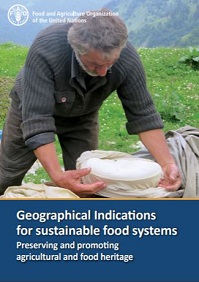
Geographical Indications for sustainable food systems
Preserving and promoting agricultural and food heritage
Geographical indications (GIs) represent a collective asset linked to local heritage and reputation. A successful GI can prevent the delocalization of production, create jobs, boost local development and contribute to safe, diversified and healthy diets, thanks to the preservation of traditional food products, environment and biodiversity.
Available also in Arabic, Russian, French, Chinese, Spanish.
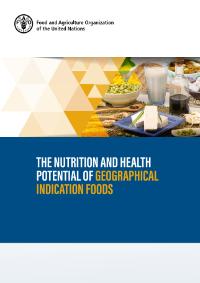
The nutrition and health potential of geographical indication foods
Traditional foods, diets and food systems play an important role in people’s nutritional status. As products of traditional food systems, geographical indication (GI) foods have a great potential to contribute to healthy diets and curb non-communicable diseases. This paper presents five case studies on the nutritional potential of registered GI foods and explores the link between the production processes and the nutritional composition of the final products. The paper also discusses the development of GI specifications to maintain and improve nutritional values, the role of GI foods in healthy diets, and the determination of food composition.
Available also in Chinese.
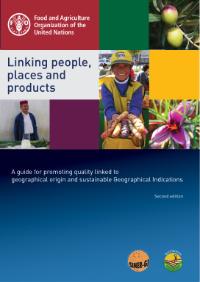
Linking people, places and products
The promotion of links among local stakeholders, their territories and their food products is a pathway for sustainable development in rural communities throughout the world. The success of such process, especially through a geographical indication (GI), is based on a series of factors described along the origin-linked virtuous circle: identification of potentials, qualification of the product, remuneration through marketing, reproduction of local resources and the roles of public policies. The Quality & Origin Programme of FAO and REDD have jointly developed this training material for the promotion of origin-linked quality and sustainable GIs in a participatory process. The material is based on the guide “Linking People, Places and Products”, and provides useful guidance and tools for trainers and trainees.
Available also in Chinese, French, Spanish, Russian, Croatian and Polish.
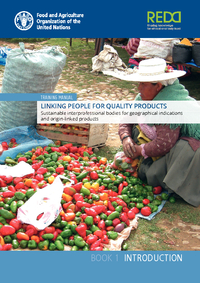
Linking people for quality products: Sustainable inter-professional bodies for geographical indications
FAO and REDD have worked together to provide a complete training tool supporting a bottom-up approach, for the promotion of origin-linked quality and sustainable geographical indications. In addition to the training material for the development of participatory procedures to preserve and promote quality products, centred on the virtuous circle of origin-linked quality, this volume, focuses on the “remuneration” phase and specifically the producers organization. Management and promotion of the specific qualities of geographical indications (GIs) by local stakeholders, gathered together in a collective management organization – the interprofession or joint body, is central to the commercial success, and ultimately to the sustainable impact, of any initiative to promote the link between a product and its origin.
The content and theory pages of this training manual set out the basic concepts, while the exercise sheets provide for participative activities. The trainer notes, together with the introduction, guide trainers in the preparation of tailored training in relation to the five steps of the virtuous circle.
Book 1: Introduction
Book 2: Content and theory
Book 3: Trainers notes
Book 4: Exercise sheets
Book 5: Case studies
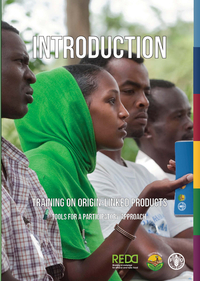
Training on origin-linked products - Tools for a participatory approach
The Quality & Origin Programme of FAO and REDD have jointly developed this training material for the promotion of origin-linked quality and sustainable geographical indications in a participatory process. Based on the guide “Linking People, Places and Products”, the “Content” sheets provide with the concepts, while the “Exercise” sheets provide with participative activities. The “Trainer” sheets together with the “introduction” will guide the trainer in the preparation of a tailored training in relation with the 5 steps of the virtuous circle.
Volume 1: IntroductionVolume 2: Sheets Trainer
Volume 3: Sheets Contents
Volume 4: Sheets Exercise
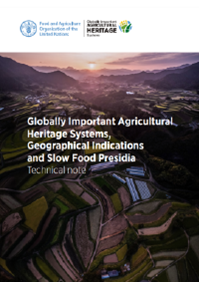
Globally Important Agricultural Heritage Systems, Geographical Indications and Slow Food Presidia
This technical note highlights the specificities of each of these three approaches, as well as the potential linkages and synergies that could be leveraged for the common goal of preserving local food systems while achieving the Sustainable Development Goals.
Also available in French.
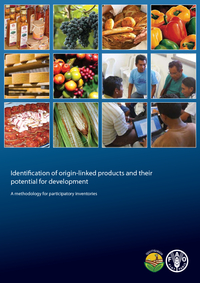
Identification of origin-linked products and their potential for development
A methodology for participatory inventories
The present study proposes a methodological participatory approach to identifying products of origin‐linked quality to be used as levers for sustainable rural development, through the virtuous circle to which they could give rise.
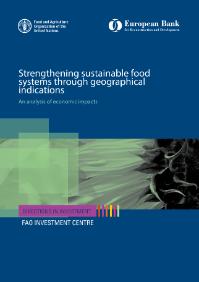
Strengthening sustainable food systems through geographical indications
An analysis of economic impacts
This study seeks to provide empirical evidence on the economic impacts that are generated through the Geographical Indication (GI) process. It focuses on the food sector and reviews nine cases, offering a variety of national contexts and local value chains. The synthetic outcome of these nine cases show the positive effect of GIs on the economy and confirm the importance of specification that is well defined and implemented through producers’ coordinated action.
PARTNERS' PUBLICATIONS
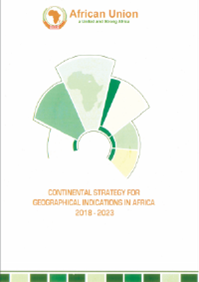
Continental Strategy for GIs in Africa (2018 - 2023)
The African Union (AU) requested FAO’s support to establish a continental strategy for GIs with three main objectives: (1) enhancing GI stakeholders’ networking at national level; (2) preserving and promoting traditional products on local markets and (3) positioning them on international markets. This strategy was endorsed by the African Union in October 2017.







